Creative Enterprise – Tearfund Ella Ross Ashleigh Blackman Annabelle Jerling Zinia Sun
Don't wanna be here? Send us removal request.
Text
Week 11/12
I had the task of putting together our presentation again,












Ashleigh
0 notes
Text
Week 11
Final iterations of social media posts that we didn’t end up using, (colours a bit off) sporting Tearfunds #ethicalfashionguidenz hashtag.



Ashleigh
0 notes
Text
Week 10
ideas for social media posts for Tearfund developed on from poster idea from week 8,


Ashleigh
0 notes
Text
week 9







beginning of zine, not long after this we ditched the idea because it was bought to our attention that people who were in shops where they would receive the zine would already be shopping ethically so wouldn’t be interested in reading our material
Ashleigh
0 notes
Text
Week 7/8
We joined up with another Tearfund group to combine our 2 ideas together. We took our initial idea of a ‘controversial media’ campaign and their idea of stickers, tags and a zine to create a mega group. We started brainstorming ideas to bring in, this is what i came up with,

Ashleigh
0 notes
Text
Survey Results
Do you know how to looks for a sustainable brand? Yes 29% - No 71%
What is an ethical clothing brand? A brand that is good for the environment - 14 votes An organic brand - 9 votes One that cares for its workers - 42 votes
Is there a difference between ethical and sustainable fashion? Yes 97% - No 3%
If yes, what is the difference? (Responses)
Ethical - cares for workers, sustainable - less harm towards the environment.
I think ethical is the morally correct way, sustainable is the environmentally friendly way.
Ethical fashion is about how the clothing label treats their workers. Sustainable clothing is about what the clothing itself is made of, also about how it is made.
Sustainable often priorities environmental and ethical often workers rights.
Not sure
Ethical is good for workers, sustainable is good for the planet.
Sustainability is environmental and ethical regards personal treatment.
Ethical considers people and the planet and sustainable considers just the planet.
Ethical is an umbrella term for everything.
Sustainable focusing on being more green, ethical focuses on workers and slave labor.
Ethical brands is more fair working rights, sustainable is production of clothes vs the environment.
Sustainability to continue operations while maintaining positive cash flow. Ethical is social factors.
Ethics is culture and behaviours. Sustainability is sourcing/creating products without harm to anyone.
Ethical cares for workers while sustainable is for the environment.
Ella
0 notes
Text
Draft Script – Ashleigh
The team profiles: Introduce ourselves
Aim/Brief: We are wanting to inform consumers & help them make better choices when they are purchasing and help them understand fast fashion more; Specifically the younger demographic (18–26 year olds) as they are the highest contributors to fast fashion.
SWOT: –
Brief within the brief: We noticed in the first few calls that the “younger demographic” came up a lot. Therefore our main priority is to target that younger audience, and build awareness regarding Tearfund & the fashion guide/report. To do this we want to look into shock advertising to “break through the advertising ‘clutter’ to capture attention and create buzz” so we can attract our targeted demographic to the report/guide.
You said/We heard: We believe more engagement between Tearfund and their audience on social media will be beneficial. People don’t engage with seeing one picture a year or so, they want a story, something they can relate to & to see that what they’re contributing to is making a difference in the world. They’ll be more willing to continue & spread the word, encouraging others.
Promotional advertising could be the way to go, campaigns, more activity on social media & just more overall engagement (all year round) with your audience can gain traction. People will usually connect/engage with something if they see an advert on the side of the street, if they don’t know about the topic they aren’t just going to go watch or read an interview. They need something eye catching/ shocking that grabs their attention and makes them think.
Insights finding the problem: Young adults are yet to gain the understanding that the Ethical Fashion Report is out there and that it is something they can use to find highly rated ethical/sustainable brands.
Although they are aware that fast fashion is an issue they do not understand the severity of it. (A negative environmental impact, water pollution, the use of toxic chemicals and increasing levels of textile waste.)
Haven't heard: Slowly the world is coming to the realisation that we need to become more ethical/sustainable in general.
What isn’t as common is the knowledge that we need to be more sustainable with our fashion consumption. People are unaware of the environmental impact from fashion/fast fashion.
It is proven that “shocking content in an advertisement significantly increases attention, benefits memory, and positively influences behavior.” (Dahl 2003, p.265) Therefore this could potentially inspire more millennials to actually take part in ethical and sustainable shopping rather than just acknowledge that it is a problem.
Controversial media: –
Identified problem: The younger demographic are unaware of Tearfund. Although many of them are aware of fast fashion they aren’t aware of the fashion report and what it promotes (graded ethical brands + low rated brands people may want to avoid).
We believe the report is not targeted enough towards the younger audience who are actually the highest consumers of fast fashion.
Research shows that people do actually want to shop through ethical/sustainable, brands but currently don’t know that they have access to a report where they can find out this information.
Identified problem cont. – website images: The fashion report is quite hard to find, Not many people would think to look under a “get involved” tab to find a fashion guide, myself included. It sounds more like “our work” as the report is something that has been made by Tearfund.
When you get the the report page, The full report is actually more than halfway down this page and is nestled in between a lot of other information, if you are unsure where to look it is quite hard to spot.
Empathy map: (Talk about target audience, how we chose them and how we describe them)
How does this relate to global trends - what is happening in the world, in terms of fashion revolution, fast fashion and environment, how do we relate to this?: We want ethical shopping to become the ‘norm’ & something the younger people will take into consideration when shopping since they are the demographic that does the most damage when it comes to fast fashion.
We want to encourage people to learn about where their clothing is coming from and the brands that they should be shopping from (via Tearfund’s report.)
Precedents: This is Good On You, they are a good example of a website/app that is successfully targeting the younger demographic. They focus on one thing only (grades regarding ethics) and is an easy to navigate site. Their app and website is a lot more visually appealing than Tearfunds. Having a better aesthetic can build more awareness in our targeted age bracket therefore deliver better results.
Mood board: –
Initial concepts/Response: “High fashion, by its nature, is meant to be audacious, teasing, groundbreaking and outrageous. And when you sport all these attributes, it’s only natural that you relish in controversy. Controversial ads and campaigns have always been abundant in the world of fashion.” Francisti, 2018.
We see this project turning into some kind of promotional advertisement for Tearfund and the ethical fashion report. Whether that be a video or typical print advertising targeted towards the younger demographic, highlighting the report.
We imagine a harsh/positive narrative as that will generate a shock “omg” factor that we believe will encourage young adults to care more about fast fashion and make them want to know more about the report.
We also picture a re-designed website specifically for the fashion report. With the possibility of an app as the younger demographic always has a phone in hand and an app is quick and easily accessible.
0 notes
Text
Draft presentation
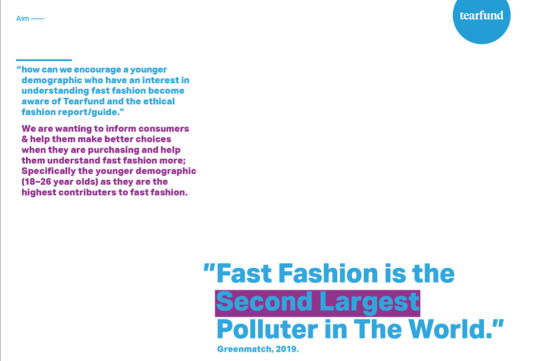



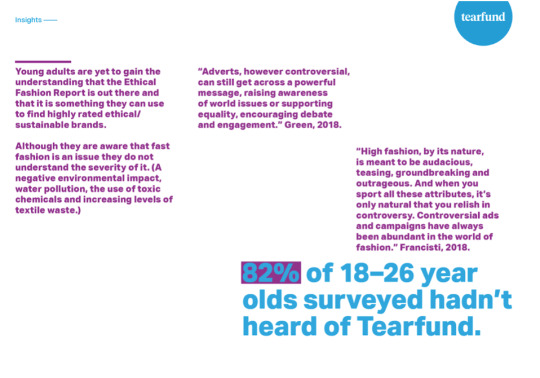

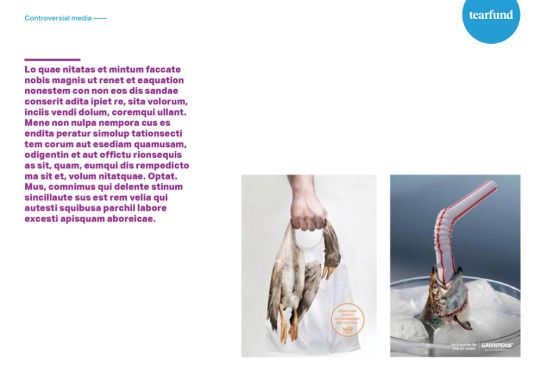
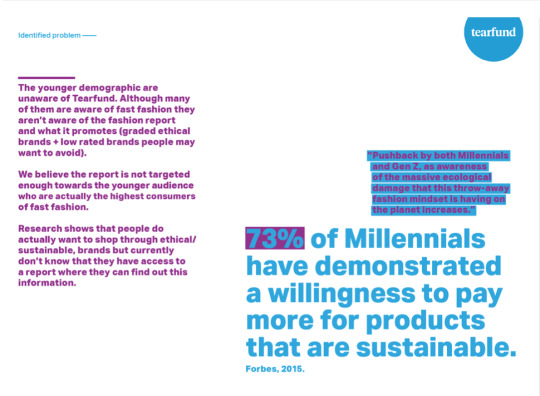

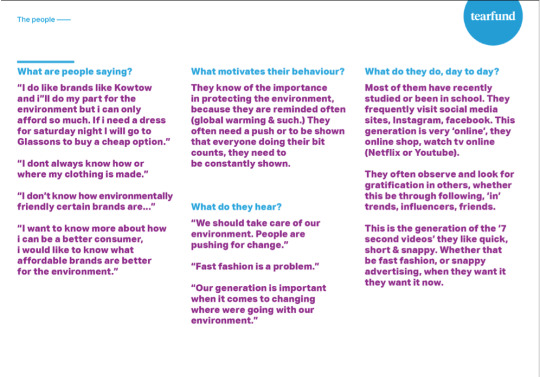

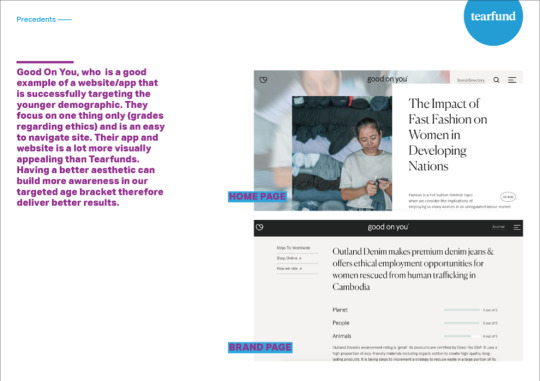
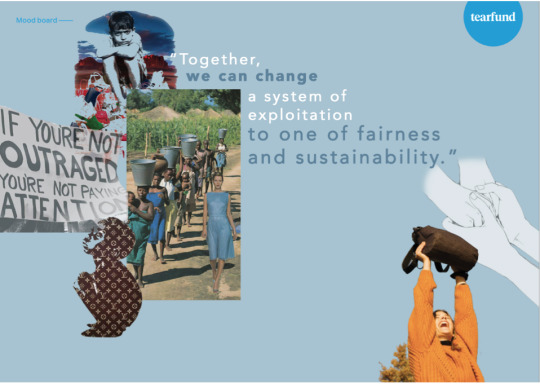
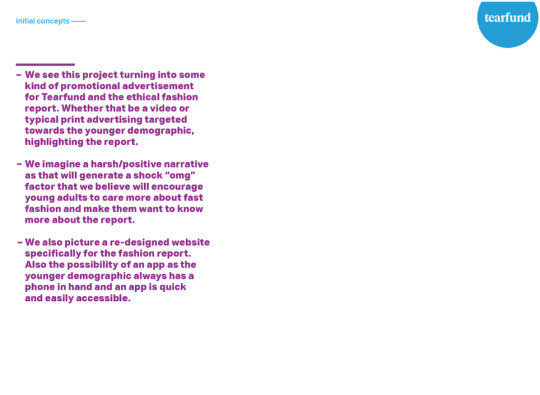

Draft presentation I have put together that we showed in week 5 to get feedback on for final presentation next week.
Ashleigh.
0 notes
Text
Zinia- The Second Survey Results

1. Do you know how to look for a sustainable or ethical brand? ( Out of 33 people (14 yes38%, 19 No62%)
2. What is the ethical clothing brand? Out of 33 people
A. A brand that is good for the environment (13 people)
B. A brand that is good for the wellbeing of workers (14 people)
C. A brand that is organic (6 people)
3. Is there different between ethical and sustainable fashion? (Out of 33 people 22 yes81% 11 No19%)

4. If yes what is different?
1. Don't know. Just think they are different. (a lot of people don’t know what is different, they just think maybe they are different, so they chose yes for the last question. And also had many people didn't answer this question...)
Answer 2. Being sustainable has to be good for the environment as well...
Answer 3. Sustainable: environmental focused. Ethical: related to stakeholder rights and interest.
Answer 4. One is about the environment and one is about the working conditions.
Answer 5. Sometimes sustainable things don’t mean ethical, and vice-versa.
- Zinia
0 notes
Text
S.W.O.T Analysis: TearFund Fashion Report
Strengths:
Emailing list - getting in touch with a more mature audience.
Having the large platform of being known for child sponsorship, rights, ethical rights.
Funded by a large organisation, will most likely always have the ability to keep the processes going.
Weakness:
Not enough media and positive chatter surrounding the report.
Needing someone to post more frequently on social media.
By being connected by Baptist World Aid, it reflects badly in terms of being known by the younger audience - they aren’t willing to make a change.
More effort needs to be placed on to making the aesthetics better and more friendly for a younger audience wanting to learn more about fast fashion.
Opportunities:
Younger demographics do want to know more, they need it shown to them.
They have the platform to really go viral.
Have influencers and people behind them.
Threats:
There are a few competitors in the market that does do this type of thing really well.
There could be more negative press surrounding the Report, in any attempt they make to have it go viral.
Annabelle
0 notes
Text
A successful sustainability marketing campaign

This is one of the few successful campaigns that make a movement for sustainable fashion. This was made in 2011 and is quite dominant, it is disheartening that this is still one of the top campaigns and it was made almost a decade ago. This is an approach Tearfund could take. This campaigns message was teaching its audience that you should pick quality over quantity and take care of the clothing that you already have.
This may not be a very aesthetically pleasing image but selective words were chosen that made people ask the important question of “why” making people want to be interested is the key. Also showing people how they can save money is a dominant idea to keep sustainability relevant and practised.
Ella
0 notes
Text
Why people don’t shop sustainably.
Slowly the world is coming to the realisation that we need to become more sustainable -- stop using plastic bags, single use bottles, straws, stop wasting water etc. What isn’t as common s the knowledge that we need to be more sustainable with our fashion consumption. People are unaware of the environmental impact from fashion and more specifically fast fashion.
“While 60 percent of millennials are interested in sustainable clothing, only 30 percent say they have actually purchased it - how many actually really did it is dubious“ (Nikki Gilliand).
What dominates the fashion industry is the desire for instant and affordable fashion. Price is the leading cause for unsustainable fashion.
“15 days for a garment to go from concept to completion.“ (Susanna Koelblin)
“Studies show that consumers are not willing to pay more for sustainable fashion and would rather pay more for style, quality and fashion which gives them value for money. If conventional products are being deeply discounted, it interferes with people’s desire to do the right thing.” (Koelblin)
“A study showed that the price of an item or how much a person liked it didn’t alone explain the amount of pleasure experienced during shopping. It was how much the person liked it and what she paid for it.” (Koelblin)
“The more data is given, the more the consumer is overwhelmed. Few consumers will actually take the time to visit a brand’s sustainability page or read a sustainability report. Sustainability information needs to be clear, visible and easily accessible, both in-store and online.” (Koelblin)
“All successful sustainability programs and brands have in common is that they had built-up the consumers’ trust long before they went to the stores.” (Koelblin)
Gilliland, Nikki. “Four Factors Fuelling the Growth of Fast Fashion Retailers.” Econsultancy, 9 Apr. 2019, econsultancy.com/four-factors-fuelling-the-growth-of-fast-fashion-retailers/.
Westwood, Vivienne, and Susanna Koelblin. “Why Consumers Don't Buy More Sustainable Fashion?” BBNtimes, 16 June 2018, www.bbntimes.com/en/technology/why-consumers-don-t-buy-more-sustainable-fashion.
Ella
0 notes
Text
controversial advertising/media


The Salvation Army in South Africa promoted its appeal for used clothing with a series of print advertisements featuring homeless people wearing a bridal gown, a superman costume, and an old military uniform.



Fabrice Monteiro traveled to the most polluted places in Africa and created terrifying characters who roamed their midst dressed in eerie debris.

A Stella McCartney campaign shot in a Scottish landfill site to raise awareness of waste and over-consumption. Fashion designer Stella McCartney condemned her industry as “incredibly wasteful and harmful to the environment” as she joined forces with the round-the-world sailor and environmental campaigner Dame Ellen MacArthur to call for a systemic change to the way clothing is produced and used.
Zinia
0 notes
Text
Ethics Form for an Ethical fashion survey



Each of us will use instagram to post questions to our peers. We think that this is a great way to ask directly to the age demographic Tearfund want to market to. We are curious of the participation of the survey and see if it reaches.
1. Have you Heard of Tear Fund??
2. Do you know what your clothing is made from?
3. Do you know any Ethical Brands? (open answer)
4. Do you care about the well-being of the people who make your clothes?
5. Which brand is the most environmentally friendly? (options to choose from)
6: Which brand is the least environmentally friendly?
7: Do you know what fast fashion is?
8: Do you shop by price (affordable) or quality?
9: Do you know how to look for a sustainable or ethical brand? (open answer)
10: What is an ethical clothing brand? (open answer)
11: What is the difference between ethical and sustainable Brands? (open answer)
Ella
0 notes
Text
Research Week4
How can help consumer they make better choices when they are purchasing and informs them a bit better.
I did some research on how to enable consumers to better understand commodity information and help them make better choices in shopping. (How can do to shop more sustainably?)
I read the articles of A Beginner's Guide to Ethical Shopping and Fashion Revolution Consumer Survey 2018. In a Fashion Revolution, Consumer Survey 2018 Survey has pointed out that "More than one in three people consider social and environmental impacts the when buying. Thanks" and, "80% of people think Fashion brands should disclose This is a sign that consumers want more transparent and intuitive brand information. We can decide to show consumers more of their want to know in the report by understanding their concerns. Although Ethical shopping is hard. Production chains are so complicated that major companies often can't guarantee what conditions their products were made in.

How to make young people pay attention to ethical fashion more naturally
In reading this report, we can summarize some problems that customers are concerned about. I think this report is quite detailed. It surveys people of all ages in every country. This allows us to intuitively understand what age group people are more concerned about what problems. for example, if our goal is to get 18-25-year-olds to know about Tearfund and to use them to influence those around them, then we can focus on what people in this age group care about more. Summarize the questions and put them in videos or reports with more simple and straightforward expressions. It's easier to get their attention. As for the issues they didn't pay much attention to before, we can mix these issues with the issues they are willing to pay attention to.
For example, when I bought clothes in the shopping mall before, I learned about the materials and sources of clothes through the self-service electronic display screen such as the iPad. The information is easier to be displayed through simple animation images, and young people likely to use self-service electronic screens when they are at shopping.
Our goal is to encourage young people who are interested in understanding fast fashion to understand Tearfund and ethical fashion report/guide. Then I think we should know what kind of issues people in this age group are more concerned about when shopping. Put the questions they are interested in in a more prominent position, leading to a guiding role that makes them more keep to attention.
At the same time, I also summarized some survey questions that appeared in this report and the percentage of people who paid attention to these questions. The information may be incomplete, the respondents come from different countries, different genders and so on... However, I think this data can give us some directions. On ethical fashion, fast fashion and environment, which are huge problems, We could consider doing some screening to be more transparent and simply show what we want to know about people in this age group.


Zinia
0 notes
Text
Theme Board to Convey Idea

This theme board is meant to illustrate the mood of our conceptual idea. Using graphic and thought provoking images to target younger demographic it then flows onto a positive message to influence the audience - to which we aim our advertisement idea does. The quotation is from Tearfund’s website that perfectly sums up their message that they want to convey to their audience.
Sourced Images from Upper Left to Lower Right:
https://www.indiatimes.com/lifestyle/self/13-powerful-images-that-show-us-exactly-whats-wrong-with-our-world-234912.html
https://wellmadeclothes.co.nz/articles/HMAccusedOfDestroyingUnwornGarments/
https://www.artsy.net/artist/beejoir
https://designyoutrust.com/2016/06/artist-joe-webb-creates-cynical-and-shocking-collages-that-tell-the-uncomfortable-truth-about-our-modern-world/
https://jajaman.co
http://yogavideos.online/full/
Annabelle
0 notes
